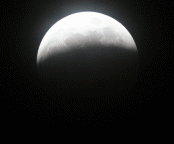Lunar eclipse
Lunar eclipse occurs when the Earth passes between the Sun and the Moon, and the Earth's shadow falls on the moon. This celestial event can only happen during a full moon, when the Sun, Earth, and Moon are nearly aligned in a straight line, an alignment also known as syzygy. Lunar eclipses can be visible from anywhere on the night side of the Earth, if the sky is clear.
Types of Lunar Eclipses
There are three types of lunar eclipses: Penumbral Lunar Eclipse, Partial Lunar Eclipse, and Total Lunar Eclipse.
Penumbral Lunar Eclipse
In a penumbral lunar eclipse, the Moon passes through the Earth's penumbra, the outer part of its shadow. This type of eclipse is subtle and hard to observe because the Moon only slightly darkens.
Partial Lunar Eclipse
A partial lunar eclipse occurs when only a part of the Moon enters the Earth's umbra, the central, darkest part of its shadow. As a result, only a portion of the Moon is darkened, which can be seen with the naked eye.
Total Lunar Eclipse
During a total lunar eclipse, the entire Moon falls within the Earth's umbra. This can result in a dramatic change in the Moon's appearance, often turning it a reddish color, commonly referred to as a "blood moon." This phenomenon occurs due to Rayleigh scattering, the same process that causes sunsets and sunrises to appear red.
Occurrence
Lunar eclipses occur at least twice a year but are not visible from the same spot each time. The number of lunar eclipses in a year can vary, with a maximum of five. Unlike solar eclipses, which are only visible from specific places on Earth, lunar eclipses can be seen by anyone on the night side of the Earth.
Observation
Lunar eclipses are safe to observe with the naked eye, unlike solar eclipses, which require protective eyewear. The duration of a lunar eclipse can vary, with total lunar eclipses lasting up to 1 hour and 40 minutes. The entire event, including the penumbral and partial phases, can last up to 5 hours.
Cultural Significance
Throughout history, lunar eclipses have held significant cultural importance. Many ancient civilizations interpreted these events as ominous, attributing them to supernatural causes or viewing them as bad omens. In modern times, lunar eclipses continue to be popular events for astronomers and skywatchers alike.
Scientific Importance
Lunar eclipses provide opportunities for scientific study, such as measurements of the Earth's rotation and refinements in the understanding of the Earth-Moon system. They have also been used to study the Moon's atmosphere and surface, offering insights into its composition.
Transform your life with W8MD's budget GLP-1 injections from $125.
W8MD offers a medical weight loss program to lose weight in Philadelphia. Our physician-supervised medical weight loss provides:
- Most insurances accepted or discounted self-pay rates. We will obtain insurance prior authorizations if needed.
- Generic GLP1 weight loss injections from $125 for the starting dose.
- Also offer prescription weight loss medications including Phentermine, Qsymia, Diethylpropion, Contrave etc.
NYC weight loss doctor appointments
Start your NYC weight loss journey today at our NYC medical weight loss and Philadelphia medical weight loss clinics.
- Call 718-946-5500 to lose weight in NYC or for medical weight loss in Philadelphia 215-676-2334.
- Tags:NYC medical weight loss, Philadelphia lose weight Zepbound NYC, Budget GLP1 weight loss injections, Wegovy Philadelphia, Wegovy NYC, Philadelphia medical weight loss, Brookly weight loss and Wegovy NYC
|
WikiMD's Wellness Encyclopedia |
| Let Food Be Thy Medicine Medicine Thy Food - Hippocrates |
Medical Disclaimer: WikiMD is not a substitute for professional medical advice. The information on WikiMD is provided as an information resource only, may be incorrect, outdated or misleading, and is not to be used or relied on for any diagnostic or treatment purposes. Please consult your health care provider before making any healthcare decisions or for guidance about a specific medical condition. WikiMD expressly disclaims responsibility, and shall have no liability, for any damages, loss, injury, or liability whatsoever suffered as a result of your reliance on the information contained in this site. By visiting this site you agree to the foregoing terms and conditions, which may from time to time be changed or supplemented by WikiMD. If you do not agree to the foregoing terms and conditions, you should not enter or use this site. See full disclaimer.
Credits:Most images are courtesy of Wikimedia commons, and templates, categories Wikipedia, licensed under CC BY SA or similar.
Contributors: Prab R. Tumpati, MD






